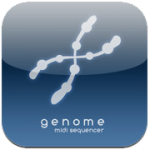Musicians can start tearing it up in the studio with Genome 1.1.0 MIDI Sequencer (GMS), a powerful pattern based MIDI sequencer for the iPad. With GMS you can control all of your MIDI gear and apps* – sequence single patterns or an entire 16 track song.
GMS easily syncs your drum machines and arpeggiators by sending and receiving MIDI clock messages. General MIDI files can be exported and imported for integration with desktop apps**.
Genome MIDI Sequencer is made for accessories like the Alesis ioDock, Line6 MIDI Mobilizer, the Yamaha i-MX1, the iRig MIDI and compatible MIDI devices using the Camera Connection Kit.
Genome also works great for sequencing other iOS apps. Now you can program melodies and basslines for apps like NLog PRO or Sunrizer while keeping a beat synced with Modrum.
IMPORTANT NOTE: GMS does does not produce any sounds by itself. Some MIDI gear, plugins or other music apps that support virtual midi connections are required to use this app.
Here’s what’s new in Genome MIDI Sequencer 1.1.0:
Fixes for playhead visual positioning issues
‘Create’ option for Grooves (create a groove template from a pattern, such as recorded MIDI notes).
Remix Pads
File management – Delete, email, Open in… (for opening files in other apps including Dropbox)
Improvements to Zooming – Zooming in and out should work a little better now in general. When zoomed out, the view now smoothly zooms in instead of abruptly zooming
New zoom mode. In additioned to the standard ‘fixed’ zoom (where X and Y scale is locked together), there’s an ‘advanced’ mode that lets you zoom X and Y are independently zoomable.
OMAC App Fast switch – This allows you to quickly switch between compatible apps (not every app supports this yet) via a menu in Genome. The button for this is on the sequencer page.
Important Change: Genome’s virtual port is no longer ‘on’ by default. You have to enable it via the config menu. The reason for this is that this is a frequent point of confusion for users. Having a virtual port can lead to issues where apps get connected twice (resulting in doubled tempos and other weird cases). It’s only necessary for Genome to have a virtual MIDI port when other apps don’t have one of their own. Only a few apps _don’t_ have virtual ports (such as Animoog), but for the majority of apps you won’t need it on.
Bugfixes and stability improvements
Not in 1.1.0 but being worked on:
MIDI Learn (for binding controllers to Patterns and Song steps) – I had wanted to get this in 1.1.0, but there are important bug fixes that need to get out now. This will be one of the first things I implement for the next update.
Features:
– CoreMIDI, Line6 Mobilizer Mk I & II compatible
– Network MIDI for sending MIDI to other iOS devices and Macs***
– Sends and Receives MIDI Clock Sync, Start and Stop events
– Also sends Note On, Note Off, Pitch Bend, Aftertouch, Channel Pressure and CC’s
– Pattern Based, pattern changes occur on bar boundaries so song stays in sync
– On screen keyboard interface
– Up to 16 simultaneous tracks, unlimited number of patterns
– Song / live modes
– Scales
– Supports background operation for multitasking
– Record incoming CC’s and Notes
– Undo / redo for most actions
* Apps must support virtual MIDI ports
** Supports exporting songs and patterns from GMS and importing MIDI loops (not complete multitrack songs).
*** Your local network conditions will affect performance. The Windows rtpMIDI driver is not officially supported at this time.
Genome is available for $12.99


